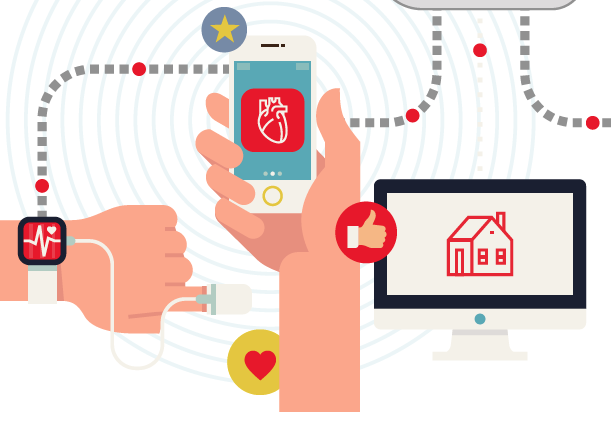 Mobile technology could revolutionize clinical research. Sensors, wearable devices, and mobile apps have the potential to offer pharmaceutical sponsors access to patient data that complement existing data and provide a more complete view of safety and efficacy.
Mobile technology could revolutionize clinical research. Sensors, wearable devices, and mobile apps have the potential to offer pharmaceutical sponsors access to patient data that complement existing data and provide a more complete view of safety and efficacy.
The number of U.S. consumers who use wearables and mobile apps for managing their health has doubled in the past two years, according to the results of a survey by Accenture. Specifically, the number of consumers who use mobile health apps increased from 16% in 2014 to 33% today, and the number of consumers who use health wearables increased from 9% to 21% during the same time.
The use of mHealth in clinical trials is increasing as well and is a trend that will dominate the market in the coming years, industry experts say. In a recent SCORR Marketing report, 50% of industry experts surveyed say they use mHealth technology in their clinical trials and protocols, and of those, 60% consider mHealth very or extremely important to their research.
As of August 29, a search of clinicaltrials.gov showed 272 studies that mention use of mHealth and 186 studies mention a wearable. These studies range from a study of cancer care coordination in chemotherapy patients to the impact of mHealth in transplant management to a wearable to promote teenagers’ physical activity.
Debbie Profit, Ph.D., leader, Otsuka Information Technology, Otsuka Pharmaceutical Development & Commercialization, suggests that a year from now, the number of studies on clinicaltrial.gov with an mHealth component could double or triple what they are today.
“We are recognizing that people use this technology every day," she says. “People now go for their phone before getting coffee. Most people have their phone with them at all times."
The use of smartphones and wearables in the general population will continue to drive usage in clinical research and is expected to have a transformative impact on pharmaceutical research.
“This is an opportunity that is and will continue to transform healthcare," says Tim Hoctor, VP, life science solutions services at Elsevier R&D Solutions.
“What we can understand about an individual based on this kind of input, whether it’s self-input or whether it’s monitored input from a wearable, will transform the way we can therapeutically treat a patient population."
The size of and cost of clinical trials is becoming unmanageable, Mr. Hoctor says, and this is driving the use of mHealth.
“Mobile capabilities give pharma access to more immediate data and to better and more collectively structured data so they can almost immediately spot a trend that would have been at best a lagging indicator when reported through the traditional clinical means," he says.
Mr. Hoctor says pharma companies can immediately see if there’s a drop off in patient utilization of a drug or spot and report on anomalies.
“That information can be viewed almost in real time," he says. “If a trend is spotted, it can be acted upon almost in real time. That’s an unheard of leap in our capabilities to monitor medicines."
 Matt Noble, senior director of product management, Medidata, says his company has seen an increase in the number of trials it is d
Matt Noble, senior director of product management, Medidata, says his company has seen an increase in the number of trials it is d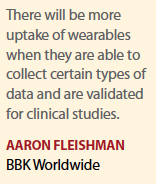 oing with an mHealth component.
oing with an mHealth component.
“We are having more conversations with customers about mHealth," he says. “As these companies think about their mobile health strategies, they want us to help them understand the options available to them today and where we see these technologies going."
Mr. Noble says sponsors are interested in capturing data — both passively and actively — that hopefully will give them insights into new clinical endpoints and a better understanding of the therapeutic area that they’re investigating. Companies also are looking to engage patients to have a stronger relationship with them in the clinical study.
“Sponsors are hoping to bring patients closer to the study, achieve better compliance, and better retention and enrollment rates," he says.
Being able to extend the patient experience beyond the clinic provides an opportunity for sponsors, says Paul Greene, Ph.D., senior VP, clinical development, INC Research.
“There is an opportunity to gather other kinds of information, along with electronic diary information, that sponsors may want for that study," he says. “In addition to receiving information from patients, these devices are starting to be configured for pushing information out to patients. It can be as simple as creating a platform for patient visit reminders or e-minders about taking the medication or for taking measurements that have to be done at home. All of these things, in fact, increase the compliance level on the study."
Pharma’s use of mHealth is, however, still in an exploratory phase.
“Pharmaceutical companies and data analytics companies are trying to find meaning in the data," Mr. Noble says. “Most life-sciences companies using mHealth technology today aren’t using it to measure the primary endpoint for their pivotal Phase III studies. Clients are just starting to understand what the data mean from a scientific perspective, a statistical perspective, and an operations perspective."
John Reites, head of digital health acceleration at Quintiles, agrees adoption of mHealth components in clinical trials is still in early stages.
“We’re just now doing a number of studies with mobile apps or wearables, so we’ve only been able to get ROI at a case-study level," he says. “We’re just now getting to the point where we have data to aggregate."
Given the scope and challenges of clinical trials, it’s not at all surprising that study teams across a wide range of disease categories are turning to mHealth solutions to help them recruit patients and monitor and measure results, says Ken Fabianovicz, senior director, commercial strategy and innovation, Cadient, a Cognizant company.
“For example, we’ve seen the promising use of mobile in respiratory trials with smart inhalers and in schizophrenia with Proteus technology," he says. “In fact, mHealth can be used in just about any trial where adherence and communication hurdles exist."
Mr. Fabianovicz says these solutions not only help study sponsors, but subjects as well, allowing them to be more connected than ever before to their clinical teams.
It’s much easier for study participants to get answers if they have the ability to ask questions 24/7, he says.
“Like any other technology, mHealth by itself is not a panacea that will remove all the challenges surrounding running a successful trial," he says. “The fundamentals still need to be followed and teams need to make the study design and protocol clear for both HCPs and participants. No amount of mHealth gadgetry can overcome a confusing and poorly conceived study.
“Looking ahead, if sponsors can collect even more data in real-time using mHealth technology, it will create significant efficiencies — both time and cost — that will help shorten timelines, and will improve subject/patient satisfaction, thereby improving retention, and future recruitment," Mr. Fabianovicz concludes.
Aaron Fleishman, director of innovation at BBK Worldwide, says there will be more uptake of wearables when they are able to collect certain types of data and are validated for clinical studies.
“Wearables are going to take off, and we’re just starting to see the uptake," he says. “A little further down the line they will be valuable to us."
The use of mHealth technology within the clinical trial process is not without its risk. For example, data validation, security, and integrity are all critical factors with widespread use of mobile devices. Additionally, devices have raised concerns about battery life, data accuracy, data interpretation and patient privacy, and the need to standardize data and establish compatibility and interoperability with existing data management systems. (See bonus content in digital edition for more on the challenges and limitations.)
In August, the Clinical Trials Transformation Initiative introduced the Mobile Clinical Trials (MCT) Program to identify and address challenges in the use of mobile technologies to facilitate clinical trials for regulatory submissions. The CTTI is implementing four projects, which focus on the following topics: legal and regulatory issues, novel endpoints, stakeholder perceptions, and use of mobile devices.
Pharma Use of mHealth Tools
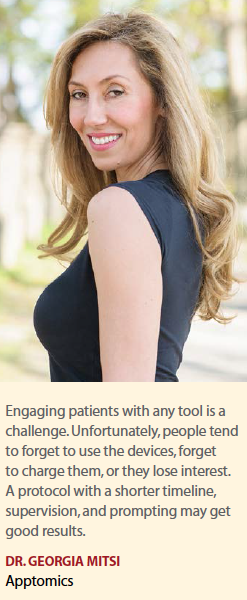 For Otsuka, Dr. Profit says, about 20% to 25% of the company’s clinical trials have an mHealth component that includes smartphone apps or wearables. In addition, the company has been looking to address the operational issues related to managing data.
For Otsuka, Dr. Profit says, about 20% to 25% of the company’s clinical trials have an mHealth component that includes smartphone apps or wearables. In addition, the company has been looking to address the operational issues related to managing data.
“Our efforts have been focused on getting our clinical trial data as close to real time as possible," she says. “We aim to do truly paperless clinical trials from start to finish from eSource, to eConsent, to ePRO, to wearables all integrated in real time. Our clinical trial data processes were dated. We are now early adopters in terms of integrating data from wearables, apps, and other mHealth tools."
When Otsuka first started using wearable devices in trials, the company was receiving tremendous amounts of data that weren’t being reconciled with other trial data, Dr. Profit says.
“This was a lesson for us," she says. “It wasn’t easy to understand who the patient was, the site where the patient was treated, etc., when you are looking strictly at wearable data. We recognized that we needed to integrate clinical trial data with wearable data in real time to obtain the maximum efficiency for study subjects and clinicians."
One example of Otsuka’s commitment to wearable data is the initiative with Proteus. The company has combined its antipsychotic medication Abilify (aripiprazole), indicated for the treatment of major depressive disorder, bipolar I disorder, and schizophrenia, with Proteus’ ingestible sensor embedded in a single tablet. This is the first time the FDA-cleared ingestible sensor was integrated with an approved medication as a combination product to measure medication-taking patterns and physiologic response. An NDA seeking approval for this product was submitted to the Food and Drug Administration in September 2015 as a system that measures medication adherence to aripiprazole.
In April, the companies received a request from the agency for additional information, including data regarding the performance of the product under the conditions in which it is likely to be used.
If approved, it will be the first digital medicine to reach the market. The Proteus sensor embedded in the pill is designed to signal a wearable patch after it reaches the stomach. The patch will record and time-stamp the ingestion of the pill and other patient metrics. The data can be relayed via Bluetooth to mobile devices and, with consent, to healthcare providers.
GlaxoSmithKline is another company that has been an early adopter of mHealth. The company has experience in more than 20 clinical trials incorporating some type of mobile device. Anytime a study requires patient diary information, the company offers patients an option to opt in through a tablet or smartphone. GSK also has looked at wearables and remote technologies in a number of therapeutic areas, including immune-inflammation, neuroscience, and respiratory.
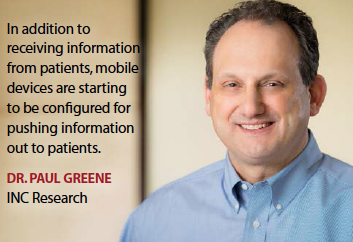 “We’ve been trying to develop different ways to measure patients’ ability to move in a much more objective way rather than have them do a 10-meter walk test or a six-minute walk test or some other physician or HCP assessment," says Julian Jenkins, Ph.D., VP, innovation performance and technology, GSK.
“We’ve been trying to develop different ways to measure patients’ ability to move in a much more objective way rather than have them do a 10-meter walk test or a six-minute walk test or some other physician or HCP assessment," says Julian Jenkins, Ph.D., VP, innovation performance and technology, GSK.
“The data are much more objective if patients can wear a device or a number of devices that allow us to understand the way a patient walks, if he is lying, sitting, or standing, and for what proportion of the day and so on."
Dr. Jenkins says the company realized it had to look at mHealth from both the patient side and the operational side.
“If we only focused on patient data but didn’t improve our operations, then we wouldn’t be able to move forward," he says.
Integration of data is critical, INC’s Dr. Greene agrees.
“One of the key things to success will be the ease with which data can be gathered through whatever technology or device and how that information can be integrated into the whole clinical database," he says. “But this can be done. We deal with it every day when we integrate central lab data, central ECG data, and central imaging data. We routinely integrate these data points into clinical databases."
The challenge will be, he says, in making those integrations not periodic but almost constant so that data become integrated in real time, making it easy for a clinician to visualize all the patient data.
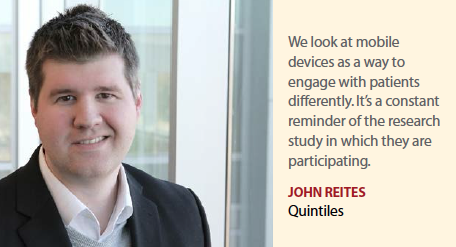 GSK is working with several partners, including the McLaren Technology Group and Medidata, to find new ways to use biosensors and mobile health platforms to improve the patient experience in the clinical trials. GSK is conducting clinical studies with biosensors and mobile devices, monitoring activity and vital signs in patients, and collecting patient feedback to improve the quality of data used to help decision-making in the development of new medicines. The company can also use this technology to send reminders to patients to help them stay on track with a protocol.
GSK is working with several partners, including the McLaren Technology Group and Medidata, to find new ways to use biosensors and mobile health platforms to improve the patient experience in the clinical trials. GSK is conducting clinical studies with biosensors and mobile devices, monitoring activity and vital signs in patients, and collecting patient feedback to improve the quality of data used to help decision-making in the development of new medicines. The company can also use this technology to send reminders to patients to help them stay on track with a protocol.
GSK and Medidata have been working together for years to evaluate the impact of unifying mHealth devices with cloud-based technologies in a clinical trial setting. The initial collaboration tested a method that has the potential to transform drug development, resulting in more efficient trials, the identification of digital biomarkers, and better insight into treatment effectiveness and patient health.
For this project, Medidata and GSK provided participants with two wearable devices. Vital Connect’s HealthPatch MD and ActiGraph’s wGT3X-BT Monitor continuously measured vital signs, electrocardiogram (ECG) data, and activity levels.
In addition, participants used Medidata Patient Cloud ePRO, a mobile app for patient-reported outcomes. The participants carried smartphones that captured data from the mHealth devices, pulled these data into the Medidata Clinical Cloud platform, and then mapped the information to the clinical record. Participants were asked to go about their standard daily routine and checked in with GSK’s Human Performance Lab only at the start and end of the effort.
In gathering real-time data on activity and vital signs per participant, per day, Medidata and GSK demonstrated that mHealth technologies have the power to comprehensively collect large volumes of objective data that are reliable, secure, and analysis-ready, and provides real-time, continuous insight into patients’ physical status.
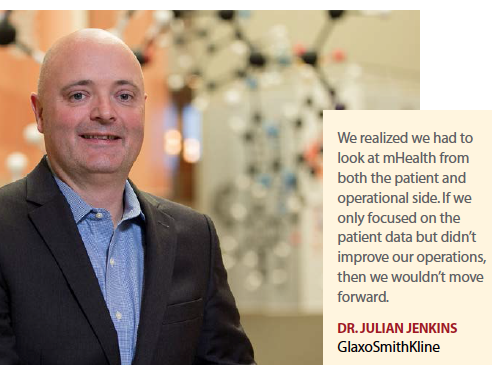 Another GSK effort is the Patient Rheumatoid Arthritis Data from the Real World (PARADE) study, which uses an iPhone app built by GSK using Apple’s ResearchKit. ResearchKit is a software framework designed specifically for medical research that helps doctors and scientists gather data more frequently and more accurately from participants using an iPhone.
Another GSK effort is the Patient Rheumatoid Arthritis Data from the Real World (PARADE) study, which uses an iPhone app built by GSK using Apple’s ResearchKit. ResearchKit is a software framework designed specifically for medical research that helps doctors and scientists gather data more frequently and more accurately from participants using an iPhone.
GSK is the first company in the industry to use Apple’s ResearchKit as part of its research, looking at the impact a patient’s disease has on his or her day-to-day life. The study uses the GSK PARADE iPhone app to conduct surveys and uses iPhone sensors to collect and track common symptoms of rheumatoid arthritis: joint pain, fatigue, and mood. It is also tracking activity and quality-of-life measures for 400 patients over a three-month period.
The app, powered by Medidata and Possible Mobile, creates a secure environment for patient data. Through the app, GSK is collecting and analyzing the data to see if it can design studies to help it develop medicines more effectively.
“Clients are interested in trying to prove certain correlations between movement and general quality of life," Mr. Noble says. “Movement is one of the easier things for people to understand, so it’s a natural place for people to start. Many clients are interested in neurological areas, looking at more discrete actigraphy and trying to measure things such as tremors and gait."
CRO Use of mHealth
CROs and other pharma partners are also beginning to look at the opportunities mHealth provides.
For example, Quintiles has been looking at mobile health as an enabling technology and using mobile-enabled technology in different ways in Phase I, Phase II, and Phase III clinical trials as well as in Phase IIIb and IV real-world, late-phase studies.
Mr. Reites says Quintiles is looking at using mobile devices as a way to engage with patients differently.
“When they have this device on, it’s a constant reminder of the research study they’re a part of, but it also means that we’re putting either an app or a wearable on somebody for all day long, which may not be something they would normally do," he says. “Additionally, there are some cases in which not everybody will have the same wearable in a study. We might be looking for a bring-your-own-device approach as a way to collect data. For some studies we may send out a very particular device because we have very specific endpoints we’re looking to collect. But in a late-phase study, where we are collecting more real world data, we may go to the patients and ask if they use a fitness app or consumer wearable and if so, provide the data they are already getting from it."
 Quintiles’ opened its global Solution Design Studio where expert teams collaborate to create technology solutions that tackle some of healthcare’s biggest challenges.
Quintiles’ opened its global Solution Design Studio where expert teams collaborate to create technology solutions that tackle some of healthcare’s biggest challenges.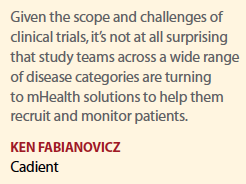
Among the projects under consideration are pilots using an eDiary mobile solution for patients, user interfaces with one-touch responses to diary questions, and integrations with different wearable devices that capture patient data.
The company also contributed open-source code to Apple’s ResearchKit to simplify how researchers gather more frequent and accurate data from research participants via iPhone. Quintiles contributed enhancements to the ResearchKit framework to provide developers with extensions that support additional capabilities that, in turn, will allow them to create more sophisticated application experiences.
In June, Quintiles launched a continuous glucose monitoring service, combining consumer wearable devices and medical device CGM to record glucose readings throughout the day. When used in clinical research, the new CGM offering will provide investigators with access to a myriad of customized data analytics and performance reports through its Infosario technology platform.
Quintiles’ Digital Health Accelerator has been specifically focused on mHealth apps/integrations, wearables devices (consumer and clinical-use), IoT, virtual research studies, and even virtual reality.
“We’ve spent a lot of time on the ecosystem for connecting wearables and medical devices so that medical devices and consumer wearables can be used in clinical trials in a way that scales," Mr. Reites says. “We’re also looking at return on investment, where we are seeing where these tools work and don’t work to help us develop principles that would help us drive adoption for our industry."
He says while the consumer apps and wearables may not necessarily have any endpoints that are used for research, they are collecting a number of components of data that are helpful for exploratory endpoints.
“These wearables are providing a lot more data in between visits that we normally can’t get to; and not just the wearable, but also some of the apps that have sensors built into the phone that are using the phone based sensors are collecting data in between visits," he says.
Another CRO that has been an early adopter of mHealth is INC Research. The company has been working with AiCure, a company that combines machine learning with smartphone technology to remind people to take their medicine. The technology sends patients a reminder, and then requests that they use the camera built into their phone to video themselves taking the medicine.
The technology is able to recognize that the person in the video is the patient, and then can identify the pill in the mouth of the patient to prove that they have taken his or her medicine.
“The AiCure technology is trying to put some rigor around verifying that a patient has actually taken the medication, taken the correct medication and has, in fact, ingested it," Dr. Greene says. “The great thing about this and the Proteus technology is that they help to ensure better compliance rates on our clinical trials and also have the ability to provide real-time feedback to investigators on subjects for which there is some doubt or question as to whether a patient has been compliant with his or her medication regimen."
Dr. Greene says leveraging a device a patient uses already can be powerful.
“The trend is moving away from providing a separate device that patients use only for that one purpose and leveraging the devices that they already use and simply adding an app to that device," he says. “The level of adoption becomes significantly higher when patients are asked to do something on a device that they already commonly use throughout their day."
Patient recruitment company BBK also is investing in how mHealth can be used to reach and engage patients. Mr. Fleishman says anywhere from 80% to 90% of BBK’s trials have some mHealth component.
“More sponsors are looking to implement mHealth tools on a study-by-study basis," he says. “We’re seeing sponsors take advantage of using mHealth tools such as schedule reminders and visit by visit guides that are provided in an app. They’re using it as an educational process to provide patients with an understanding of not just study-specific requirements but in general what our clinical trials are as a whole."
Mr. Fleishman says one of the big misconceptions is that an app has to have a high-tech innovative component to it to enrich the patient’s experience.
“In actuality, the app itself is another vehicle to provide the same types of information that we’ve been providing our patients for years. It’s taking all that information from a traditional standpoint of something that’s a pamphlet, a flyer or a brochure and digitizing it in a way to provide a new avenue to communicate with patients."
He points out, however, that sponsors can’t solely rely on mHealth tools to provide the best engagement experience for patients. mHealth tools, he says, provide another way for engagement, but do not solve engagement on its own.
BBK is partnering with Apptomics, a provider of digital health solutions for patients living with chronic neurological conditions, to develop a new suite of mobile apps for patients, caregivers, physicians and payers. The digital health solution, iMotor, monitors and measures objectively motor performance for patients with Parkinson’s disease.
Apptomics has completed two patient studies in collaboration with the University of Cincinnati that show the scientific validity of its Parkinson’s disease digital health solution. iMotor can accurately discriminate Parkinson’s disease from healthy volunteers and detect effects of treatment with high sensitivity using proprietary technology and algorithms.
“Parkinson’s patients often need to keep paper diaries about what is happening in their everyday life," says Georgia Mitsi, Ph.D., CEO and founder of Apptomics. “As you can imagine, compliance is very low. Data quality is poor. But these data are very important for clinicians because it helps them understand if and how the drugs are working, what kind of side effects patients may have, or whether they are dealing with any issues related to their emotional health."
Apptomics created an electronic diary to report patient data, as well as a tool that can measure patients’ motor performance through tapping. The tool provides three specific tests that a patient can perform on the screen of a tablet. The first test requires patients to tap between the two targets as fast as they can and as accurately as they can.
The second test is the “palm test," which replicates a specific test (pronation-supination) that is part of the physician’s neurological evaluation in an office visit. The last test, which focuses on reaction time, also has a cognitive element.
“From these tests, the physician can determine how severe the symptoms are," Dr. Mitsi says. “They can also tell the treatment impact. Parkinson’s is one of those conditions that fluctuates a lot and getting an idea of a patient’s everyday life is critical. These objective measures allow for a real-time understanding of how well the treatment is working and the severity of the disease. Instead of waiting for the next follow-up visit that can take place after four or five months, physicians can intervene faster."
Later this year, BBK and Apptomics will work with recognized neurological institutions in the United States to conduct a 12-month randomized, controlled trial focusing on the solution’s impact on disease management, patient outcomes, and healthcare utilization of resources for Parkinson’s disease.
The study will enroll between 90 and 100 patients at five research sites, Dr. Mitsi says.
“This study aims to show how using digital tools can be part of the medication management and everyday care," she says. “We’re hoping that if we show improvement in specific health outcomes and reduction in healthcare utilization resources, we will be able to start the discussion with key opinion leaders and other practicing physicians about how using simple digital tools physicians can provide value-based care for their patients." (PV)


















